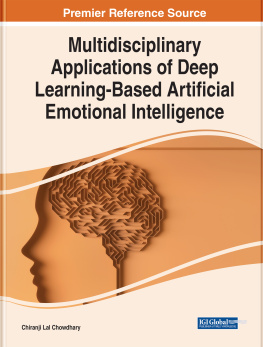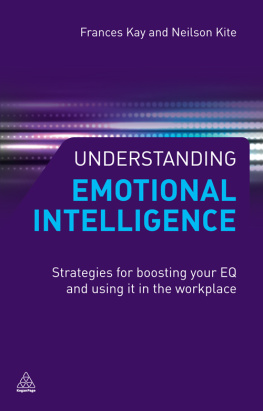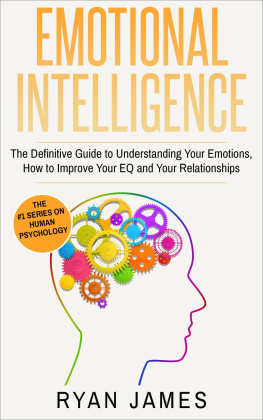Joseph Ciarrochi - Applying Emotional Intelligence: A Practitioners Guide
Here you can read online Joseph Ciarrochi - Applying Emotional Intelligence: A Practitioners Guide full text of the book (entire story) in english for free. Download pdf and epub, get meaning, cover and reviews about this ebook. City: Hove, year: 2007, publisher: Psychology Press, genre: Home and family. Description of the work, (preface) as well as reviews are available. Best literature library LitArk.com created for fans of good reading and offers a wide selection of genres:
Romance novel
Science fiction
Adventure
Detective
Science
History
Home and family
Prose
Art
Politics
Computer
Non-fiction
Religion
Business
Children
Humor
Choose a favorite category and find really read worthwhile books. Enjoy immersion in the world of imagination, feel the emotions of the characters or learn something new for yourself, make an fascinating discovery.
- Book:Applying Emotional Intelligence: A Practitioners Guide
- Author:
- Publisher:Psychology Press
- Genre:
- Year:2007
- City:Hove
- Rating:4 / 5
- Favourites:Add to favourites
- Your mark:
- 80
- 1
- 2
- 3
- 4
- 5
Applying Emotional Intelligence: A Practitioners Guide: summary, description and annotation
We offer to read an annotation, description, summary or preface (depends on what the author of the book "Applying Emotional Intelligence: A Practitioners Guide" wrote himself). If you haven't found the necessary information about the book — write in the comments, we will try to find it.
Applying Emotional Intelligence: A Practitioners Guide — read online for free the complete book (whole text) full work
Below is the text of the book, divided by pages. System saving the place of the last page read, allows you to conveniently read the book "Applying Emotional Intelligence: A Practitioners Guide" online for free, without having to search again every time where you left off. Put a bookmark, and you can go to the page where you finished reading at any time.
Font size:
Interval:
Bookmark:
APPLYING EMOTIONAL INTELLIGENCE
A Practitioner's Guide
edited by
Joseph Ciarrochi
University of Wollongong
John D. Mayer
University of New Hampshire

Published in 2007
by Psychology Press
711 Third Avenue,
New York, NY 10017
www.psypress.com
Published in Great Britain
by Psychology Press
27 Church Road,
Hove, East Sussex BN3 2FA
www.psypress.co.uk
Psychology Press is an imprint of the Taylor & Francis Group, an informa business
Copyright 2007 Psychology Press
Typeset by RefineCatch Limited, Bungay, Suffolk, UK
Paperback cover design by Hybert Design
All rights reserved. No part of this book may be reprinted or reproduced or utilized in any form or by any electronic, mechanical, or other means, now known or hereafter invented, including photocopying and recording, or in any information storage or retrieval system, without permission in writing from the publishers.
Library of Congress Cataloging-in-Publication Data
Applying emotional intelligence: a practitioner's guide / edited by
Joseph Ciarrochi & John D. Mayer.
p. cm.
Includes bibliographical references and index.
ISBN-13: 978-1-84169-461-0 (hardback: alk. paper)
ISBN-13: 978-1-84169-462-7 (pbk.: alk. paper) 1. Emotional intelligence.
I. Ciarrochi, Joseph. II. Mayer, John D., 1953
BF576.I47 2007
152.4dc22
2006033852
ISBN: 978-1-84169-461-0 (hbk)
ISBN: 978-1-84169-462-7 (pbk)
| Joseph Ciarrochi and John D. Mayer |
| Marc A. Brackett and Nicole A. Katulak |
| Richard E. Boyatzis |
| Susan A. Kornacki and David R. Caruso |
| Joseph Ciarrochi, John Blackledge, Linda Bilich, and Virginia Bayliss |
| John D. Mayer |
| Joseph Ciarrochi and John D. Mayer |
Joseph Ciarrochi received his Ph.D. degree from the University of Pittsburgh, a postdoctoral fellowship in emotion research from the University of New South Wales, and currently has a position as lecturer in psychology at the University of Wollongong. He has been conducting cutting-edge research in how emotions influence thinking and behavior and how emotional intelligence can best be measured and used. His findings have been published in the top journals in psychology and have been presented at numerous international conferences. Dr. Ciarrochi is currently evaluating training programs that are designed to increase peoples social and emotional intelligence.
John (Jack) D. Mayer received his B.A. degree from the University of Michigan, his M.A. and Ph.D. in psychology at Case Western Reserve University, and then attended Stanford University as a National Institute of Mental Health Post-doctoral Scholar. Dr. Mayer has served on the editorial boards of Psychological Bulletin and Journal of Personality . He has published numerous scientific articles, book chapters, psychological tests, and books. His articles, with Salovey, in the early 1990s are often credited with beginning research on emotional intelligence.
Virginia Bayliss
Management and Workplace Programs Continuing Education Directorate, New South Wales Police, Sydney, Australia
Linda Bilich
School of Psychology, University of Wollongong, Australia
John Blackledge
School of Psychology, University of Wollongong, Australia
Richard E. Boyatzis
Department of Organizational Behavior and Psychology, Weatherhead School of Management, Case Western Reserve University, USA
Marc A. Brackett
Department of Psychology, Yale University, USA
David R. Caruso
Department of Psychology, Yale University and EI Skills Group, USA
Joseph Ciarrochi
School of Psychology, University of Wollongong, Australia
Nicole A. Katulak
Department of Psychology, Yale University, USA
Susan A. Kornacki
EI Skills Group, USA
John D. Mayer
Department of Social Psychology/Personality, University of New Hampshire, USA
Joseph Ciarrochi
John D. Mayer
Programs designed to promote social and emotional effectiveness are being tested all over the world, and there is growing evidence for their effectiveness.1 The central part of this book presents four fascinating interventions in emotional intelligence (EI), developed by some of the most innovative practitioners (and researchers as well, in most instances) side by side. We want you to get a clear sense of what is in the interventions, and how they are similar and different.
We did not want to create yet another EI theory book that describes ideas but provides little that is of direct use to the practitioner. All authors were encouraged to specify, in concrete terms, exactly what was done in their interventions. The book is intended to serve as a guide for future intervention research and for people who would like to engage in EI interventions and make a positive difference in peoples lives.
There are many, quite different, approaches to training, coaching, and educating people to improve their personalities in general and emotional intelligence in particular. We have selected four of what we regard as among the best in the area of EI. Some of these programs focus on EI as we would define it; others extend into the far broader terrain of overall personality development.
The four interventions are set up so that readers can appreciate them on their own terms, without evaluation. Then, in the final section of the book, we compare and contrast the interventions, and attempt to identify the key ingredients that are in each intervention; we also discuss personality change more generally. A brief description of the chapters follows.
In , Brackett and Katulak provide a detailed description of a school-based EI intervention. The approach is based on the EI-ability model of Mayer et al.2 The chapter provides powerful exercises that are designed to improve EI amongst both teachers and students. It also provides useful EI worksheets that help to structure the EI intervention. Finally, the chapter reports preliminary findings on the benefits of the school-based EI intervention for improving well-being, social skills, and grades.
, Boyatzis presents a broader program for developing personal and interpersonal skills in professionals, managers, and leaders. The program develops personal competencies such as self-awareness, self-management, social awareness, and social management. Using intentional change theory, Boyatzis illustrates how to guide a person through five key life discoveries. The program helps people to clarify their values, and to develop a plan to put these values into play. People are shown how to develop competencies through practice and experiential feedback. The chapter presents longitudinal data suggesting that the Boyatzis EI program can have a long-term impact on peoples awareness and management skills.
In , Kornacki and Caruso describe ten ways to improve EI skills in the workplace. The chapter provides a coherent theoretical approach, based on the EI-ability model.2 It takes readers through a series of case studies to provide concrete illustrations of the EI skills in action. It provides readers with EI assessment and self-development exercises. The intervention is clearly articulated and taught in terms of an Emotional Blueprint, which provides a structured way for people to look at and improve on their emotional experience.
In , Ciarrochi, Blackledge, Bilich, and Bayliss describe a mindfulness-based approach to emotional intelligence training (MBEIT). Unlike other approaches, MBEIT does not teach emotion management skills. Instead, people are taught how to experience their emotions, fully and without defense, and to still do the things they value most. The program focuses on teaching people to let go of unhelpful emotion control strategies, to undermine the power of emotions and thoughts to act as barriers to effective action, and to discover personal values and develop a clear action plan for working toward those values. The program is designed to improve well-being, increase flexibility and effectiveness, and improve interpersonal relationships. The MBEIT approach has received substantial support in the clinical literature and is receiving increasing support within normal populations, in workplace and other settings.
Font size:
Interval:
Bookmark:
Similar books «Applying Emotional Intelligence: A Practitioners Guide»
Look at similar books to Applying Emotional Intelligence: A Practitioners Guide. We have selected literature similar in name and meaning in the hope of providing readers with more options to find new, interesting, not yet read works.
Discussion, reviews of the book Applying Emotional Intelligence: A Practitioners Guide and just readers' own opinions. Leave your comments, write what you think about the work, its meaning or the main characters. Specify what exactly you liked and what you didn't like, and why you think so.







